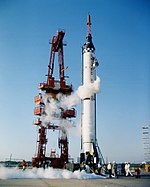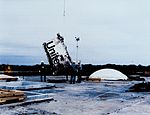Cape Canaveral Launch Complex 25
Launch Complex 25 (LC-25) was a four-pad launch site at Cape Canaveral Space Force Station, Florida built for test flights of the US Navy's submarine-launched ballistic missiles Polaris, Poseidon and Trident from 1958–1979.Pads 25A and 25B were built in 1957. Pads 25C and 25D were added in May 1968 for the larger Poseidon. The blockhouse eventually served all four pads. It was extensively reinforced when the Poseidon pads, 25C and 25D, were added. Pad 25B was initially built with an underground launch mechanism known as a ship motion simulator to simulate the roll and pitch of a submarine. It was first used August 14, 1959 and was mothballed in October 1961.The launch complex was dismantled in 1979. In November 2012, ground was broken for a new $185-million Navy missile test facility to be built over the underground structures at LC-25 and LC-29 called the Strategic Weapon System Ashore. The facility will allow the testing of fire control, launch systems and navigation for submarine-fired missiles to be conducted at one facility instead of being done by contractors in different locations around the country.
Excerpt from the Wikipedia article Cape Canaveral Launch Complex 25 (License: CC BY-SA 3.0, Authors).Cape Canaveral Launch Complex 25
Pier Road,
Geographical coordinates (GPS) Address External links Nearby Places Show on map
Geographical coordinates (GPS)
| Latitude | Longitude |
|---|---|
| N 28.431988 ° | E -80.576943 ° |
Address
Launch Complex 25
Pier Road
32920
Florida, United States
Open on Google Maps







